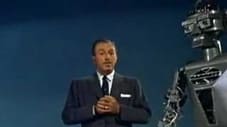Ward Kimball — Director
Episodes 2
Man in Space
"Man in Space" is an episode of Disneyland which originally aired on March 9, 1955. It was directed by Disney animator Ward Kimball. Later, it was edited into a featurette to play in theaters, accompanying Davy Crockett and the River Pirates. This Disneyland episode, was narrated partly by Kimball and also by such famed scientists as Dr. Willy Ley, Dr. Heinz Haber, Dr. Wernher von Braun and Dick Tufeld of Lost in Space fame. The show talks briefly about the lighthearted history of rockets and is followed by discussions of satellites, a practical look at what spacemen will have to face in a rocket and a rocket takeoff into space.
An adaptation of the episode was published by Dell as Four Color #716 in 1956, scripted by Don R. Christensen with art by Tony Sgroi. It was actually a "novelization" in comic book form of two Walt Disney television programs, "Man in Space" and "Tomorrow the Moon". Also found as a 1956 UK reprint as "A World Distributors Movie Classic" and a 1959 combined reprint with the other 2 Dell Comics adaptations of "Man in Space" films as "Walt Disney's Man in Space".
Read MoreMars and Beyond
"Mars and Beyond" is an episode of Disneyland which aired on December 4, 1957. It was directed by Ward Kimball and narrated by Paul Frees. This episode discusses the possibility of life on other planets, especially Mars. It begins with an introduction of Walt Disney and his robot friend Garco, who provide a brief overview. It continues with an animated presentation about mankind seeking to understand the world in which he lives, first noticing patterns in the stars, and developing certain beliefs regarding the celestial bodies. Theories from scientists and philosophers are discussed, including Ptolemy's inaccurate, but formerly-accepted theories, as well as those of Copernicus. Life on other planets is considered, soon focusing on Mars. Ideas from science-fiction authors H.G. Wells and Edgar Rice Burroughs are brought to life with more colorful animation. Pulp science fiction comics of the time are parodied in the same straightforward tone as everything else.
After this, the program adopts a serious tone as it profiles each of the planets in the solar system, from the perspective of what would happen to a man on them. The program claims that whereas most of the planets are either too cold or too hot for life as we know it, life on Mars could almost be normal, something that is of increasing importance for the future. Dr. E.C. Slipher then discusses the Red Planet and the possibility that life is already there. More animation speculates what the conditions on Mars might be like. This section is filled with striking, inventive and atypical Disney animation.
Read More

